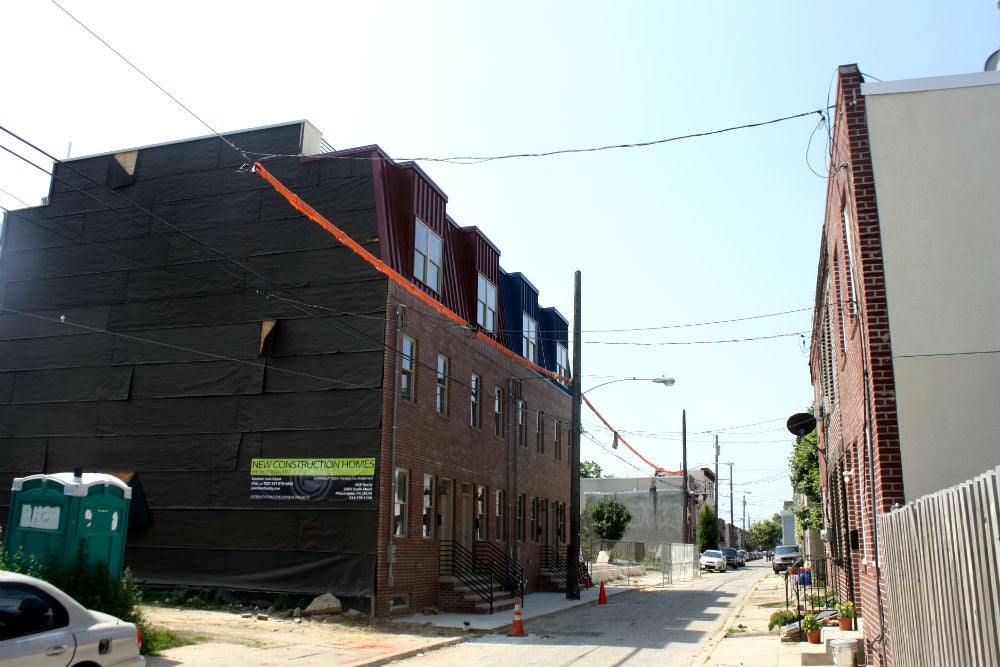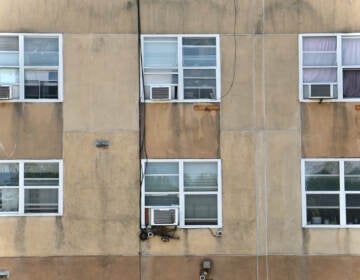Fate uncertain for tangled housing project in Point Breeze

Either Councilman Kenyatta Johnson is blocking a construction project proposed by developer Ori Feibush, who plans to challenge Johnson in next year’s City Council race, or Ori Feibush is refusing to alter his plans in response to complaints from neighbors.
Or both.
Or possibly neither.
It’s been almost two months since the zoning board held a hearing about a second phase of an OCF Realty project that involves a total of 22 new homes on S. Chadwick Street in Point Breeze, each three stories tall with a roof deck and mansard roof that tapers back from the property line above the second story. The board has yet to hand down a decision.
The ZBA had already approved variances for about half of the houses, with no opposition from Councilman Johnson’s office. But once Feibush started building, some neighbors complained that the houses were bigger than they’d bargained for and said the construction was doing damage to their sidewalks.
So when the second phase went before the board, Johnson’s office didn’t support the variance.
The variance Feibush is seeking—and which he received for the other houses on the block—is for the size of the rear yard. Feibush says he can’t fit three bedrooms into a three-story house on a lot as small as those on Chadwick Street while meeting the rear-yard setback required by the zoning code. He also says he can’t sell a house in the neighborhood with fewer than three bedrooms.
“In order to get three bedrooms and two baths—which is generally not just what sells, but it sells because that’s what people are looking for, it’s younger families moving into the community—in order to do that we need to get three bedrooms,” Feibush told PlanPhilly after the ZBA hearing in June. “And the only way to do that, building by right, is to go four stories. Which is not what we’d like to do.”
Worth emphasizing: Feibush could build a 38-foot home with a 10-foot pilot house on top without getting a zoning variance. What he is proposing has a smaller backyard than what he could build by right, but it is 33 feet at its highest point. That’s evidence, he says, that he’s compromised enough.
“The homes that we had proposed were the shortest new-construction single-family homes that have been proposed in that neighborhood,” he said. “Period.”
Feibush said that Councilman Johnson’s office is using the Registered Community Organization process as a “proxy” to stop the development. He pointed out that another developer proposing a house that he says is identical to his proposals received a variance from the zoning board earlier this month—for a project on the same block.
But Councilman Johnson’s office points out that they didn’t oppose the first phase of the project. In addition, Councilman Johnson actually introduced and voted for a resolution transferring one of the properties on Chadwick Street to Feibush late last year—after Feibush announced he’d challenge Johnson for the Council seat.
“Councilman Johnson welcomes development and tends not to voice his concern regarding zoning variances unless he hears significant concerns from neighbors,” said Steve Cobb, an aide to Councilman Johnson, in an email. “In the case involving one home, Councilman Johnson’s office received only one complaint, so he did not take any position. He did not support this [single-property] project, or even offer a letter of non-opposition, he just deferred to the ZBA … One case involves a single home with no significant opposition, the other involves a plan to transform the entire block with significant opposition from an RCO and immediate neighbors.”
Frank Kumas, the builder of the single house on Chadwick Street who received the zoning variance earlier this month, declined to comment.
(Worth noting: according to Feibush, Johnson did not support the first phase of the project at the zoning board, despite introducing the Council resolution selling him the property. He said the redevelopment agreement was made before Feibush announced he’d run for Council, and that after he announced, Johnson dragged his feet.)
A small handful of RCOs operate in the Point Breeze area, and they don’t always see eye to eye. Newbold Neighbors Association, for example, voted to support OCF’s Chadwick Street projects during both phases. Feibush emphasizes that support; Johnson’s office acknowledges it. But another group, Point Breeze Community Development Coalition, voted to oppose the second phase of the project, according to a letter signed by representatives of that group.
“The immediate neighbors and the Community OPPOSED this project as presented at the Community Meeting,” reads a letter signed by Coalition chair Zelda Simpkins, as well as president Claudia Sherrod, who is also the director of South Philadelphia H.O.M.E.S. “This is the second Community Meeting and at each one they opposed this project. The current construction destroyed properties and they are bigger in appearance, than they were presented. The developer will not work with near neighbors and the majority of the block is two stories and they changed the existing houses.”
(Additionally, Feibush started an RCO called Point Breeze Community Development Corporation, but he said that group doesn’t hear zoning applications because it would be a conflict of interest.)
Feibush says he met with every neighbor on the block, and that most support the project.
Earlier this summer, PlanPhilly went knocking on doors and got a range of opinions. It was mid-afternoon, and the sample size was unscientific, but different neighbors expressed support, opposition, and indifference to the new and proposed OCF homes.
One neighbor, Pamela Stroman-Gibson, had also appeared at the June hearing before the zoning board. Gibson said that while neighbors had initially been pleased by OCF’s Chadwick Street proposals, the buildings themselves didn’t meet their expectations. For one thing, she said, the mansard roofs don’t taper back as much as they should. The OCF project is essentially overshadowing a two-story block with three-story houses, she said.
There’s another wrinkle. While Feibush’s Chadwick Street properties were assigned to the Point Breeze Community Development Coalition as the “coordinating RCO”—the group that must convene the meeting of all RCOs and near neighbors—the single-property project proposed by Frank Kumas was assigned to Newbold Neighbors Association.
PlanPhilly asked the Planning Commission how the coordinating RCO is selected.
“Staff contacts each council office for each appeal, indicating the RCOs and City Council assigns the coordinating RCO,” wrote Eleanor Sharpe, the Commission’s legislative affairs director, in an email. “If we don’t get this feedback from Council in a timely manner to meet our deadlines, staff assigns a coordinating RCO and informs City Council of our choice. This happens less frequently—so the short answer is City Council chooses.”
Johnson’s office said it doesn’t matter who the coordinating RCO is.
“Before taking a position on a project, the Councilman considers the positions of all RCOs and near neighbors regardless of which organization is considered ‘coordinating,’” said Steve Cobb. “Councilman Johnson opposed [OCF’s] project because, although one RCO supported it, the other RCO and a number of immediate neighbors opposed it.”
If you’re feeling a little lost here, you’re not alone.
Here’s the rub: some Point Breeze residents are concerned about the scale of new development going into the neighborhood, which has a lot of two-story houses. Some also wish Feibush would be more flexible with his plans; the Chadwick Street properties have amenities like a wet bar and powder room on the third floor that some neighbors see as unnecessary.
Feibush says his current proposal is as small as he’s willing to go. Moreover, because one of his properties was obtained through a Redevelopment Authority contract, he has to start building within a year. If the ZBA doesn’t approve his current proposals—which, he emphasizes, are identical to a handful of proposals the board already approved—he’ll revert to a by-right proposal.
And a by-right proposal here would mean keeping the code’s required rear-yard setback, but building to the full 38-foot height limit and adding pilot houses on top.
“We could build by right here, and it would be to the detriment of the block, and it would be disappointing to put our names on a project that we frankly don’t love the aesthetics of, because it’s a two-story block and it would be a four-story home,” Feibush said, back in June. “… We’ll respect whatever feedback the zoning board ultimately decides here, and if they want a by-right build here—we’re not proud of it, but at the end of the day, we are under a legal obligation from the city to build within 12 months, and that timeframe started some time ago. It’s not what I’d like to build. It’s not my first, second, or third choice, but if we’re building by right, we’re building by right, and we have to get three bedrooms by going another story.”
WHYY is your source for fact-based, in-depth journalism and information. As a nonprofit organization, we rely on financial support from readers like you. Please give today.






